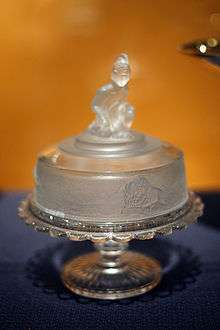Frosted glass
Frosted glass windows used in a restroom

James Gillinder & Sons (1860 – ca. 1935). "Westward Ho!" Compote, ca. 1875. Pressed colorless and frosted glass. Brooklyn Museum
Frosted glass is produced by the sandblasting or acid etching of clear sheet glass. This creates a pitted surface on one side of the glass pane and has the effect of rendering the glass translucent by scattering the light which passes through, thus blurring images while still transmitting light.
Applications:
- To achieve visual privacy while still allowing light to pass through.
- Decorative patterns may be created on plain glass by using wax or other inhibitors to retain transparent areas.
- Frosted glass in light bulbs is used for evenly distributing the light from the bulb's filament across its surface area.
- To distribute light uniformly in a photographic contact printer.
- To create an airtight seal in tubes.
The frosted glass effect can also be achieved by the application of vinyl film, used as a sort of stencil on the glass surface. "Photo-resist", or photo-resistant film is also available, which can be produced to mask off the area surrounding a decorative design, or logo on the glass surface. A similar effect may also be accomplished with the use of canned frosted glass sprays.
See also
References
This article is issued from
Wikipedia.
The text is licensed under Creative Commons - Attribution - Sharealike.
Additional terms may apply for the media files.